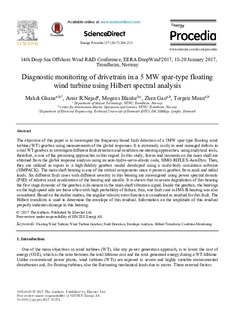| dc.contributor.author | Ghane, Mahdi | |
| dc.contributor.author | Nejad, Amir Rasekhi | |
| dc.contributor.author | Blanke, Mogens | |
| dc.contributor.author | Gao, Zhen | |
| dc.contributor.author | Moan, Torgeir | |
| dc.date.accessioned | 2017-12-28T12:58:19Z | |
| dc.date.available | 2017-12-28T12:58:19Z | |
| dc.date.created | 2017-12-23T12:44:25Z | |
| dc.date.issued | 2017 | |
| dc.identifier.citation | Energy Procedia. 2017, 137, 204-213. | nb_NO |
| dc.identifier.issn | 1876-6102 | |
| dc.identifier.uri | http://hdl.handle.net/11250/2473825 | |
| dc.description.abstract | The objective of this paper is to investigate the frequency-based fault detection of a 5MW spar-type floating wind turbine (WT) gearbox using measurements of the global responses. It is extremely costly to seed managed defects in a real WT gearbox to investigate different fault detection and condition monitoring approaches; using analytical tools, therefore, is one of the promising approaches in this regard. In this study, forces and moments on the main shaft are obtained from the global response analysis using an aero-hydro-servo-elastic code, SIMO-RIFLEX-AeroDyn. Then, they are utilized as inputs to a high-fidelity gearbox model developed using a multi-body simulation software (SIMPACK). The main shaft bearing is one of the critical components since it protects gearbox from axial and radial loads. Six different fault cases with different severity in this bearing are investigated using power spectral density (PSD) of relative axial acceleration of the bearing and nacelle. It is shown that in severe degradation of this bearing the first stage dynamic of the gearbox is dominant in the main shaft vibration signal. Inside the gearbox, the bearings on the high speed side are those often with high probability of failure, thus, one fault case in IMS-B bearing was also considered. Based on the earlier studies, the angular velocity error function is considered as residual for this fault. The Hilbert transform is used to determine the envelope of this residual. Information on the amplitude of this residual properly indicates damage in this bearing. | nb_NO |
| dc.language.iso | eng | nb_NO |
| dc.publisher | Elsevier | nb_NO |
| dc.rights | Attribution-NonCommercial-NoDerivatives 4.0 Internasjonal | * |
| dc.rights.uri | http://creativecommons.org/licenses/by-nc-nd/4.0/deed.no | * |
| dc.title | Diagnostic monitoring of drivetrain in a 5 MW spar-type floating wind turbine using Hilbert spectral analysis | nb_NO |
| dc.type | Journal article | nb_NO |
| dc.type | Peer reviewed | nb_NO |
| dc.description.version | publishedVersion | nb_NO |
| dc.source.pagenumber | 204-213 | nb_NO |
| dc.source.volume | 137 | nb_NO |
| dc.source.journal | Energy Procedia | nb_NO |
| dc.identifier.doi | 10.1016/j.egypro.2017.10.374 | |
| dc.identifier.cristin | 1531772 | |
| dc.description.localcode | © 2017 The Authors. Published by Elsevier Ltd. This is an open access article under the CC BY-NC-ND license (http://creativecommons.org/licenses/by-nc-nd/4.0/). | nb_NO |
| cristin.unitcode | 194,64,20,0 | |
| cristin.unitcode | 194,63,25,0 | |
| cristin.unitname | Institutt for marin teknikk | |
| cristin.unitname | Institutt for teknisk kybernetikk | |
| cristin.ispublished | true | |
| cristin.fulltext | original | |
| cristin.qualitycode | 1 | |

